Copyright – An Engine of Free Expression: An Essay
VerifiedAdded on 2022/12/23
|9
|2822
|1
Essay
AI Summary
This essay delves into the multifaceted role of copyright as a driving force behind free expression. It examines how copyright laws incentivize creativity by providing authors with economic benefits and legal protections against piracy and unauthorized reproduction. The essay explores the historical context of copyright, tracing its evolution from the Statute of Anne to modern-day applications, including the impact of the First Amendment and the balance between copyright and freedom of speech. The discussion highlights how copyright fosters innovation and dissemination of ideas, while also acknowledging the viewpoints of experts who argue that it can restrict free expression. The essay concludes by emphasizing the crucial role of copyright in promoting the creation and dissemination of artistic and intellectual works, ultimately contributing to a richer and more diverse society.
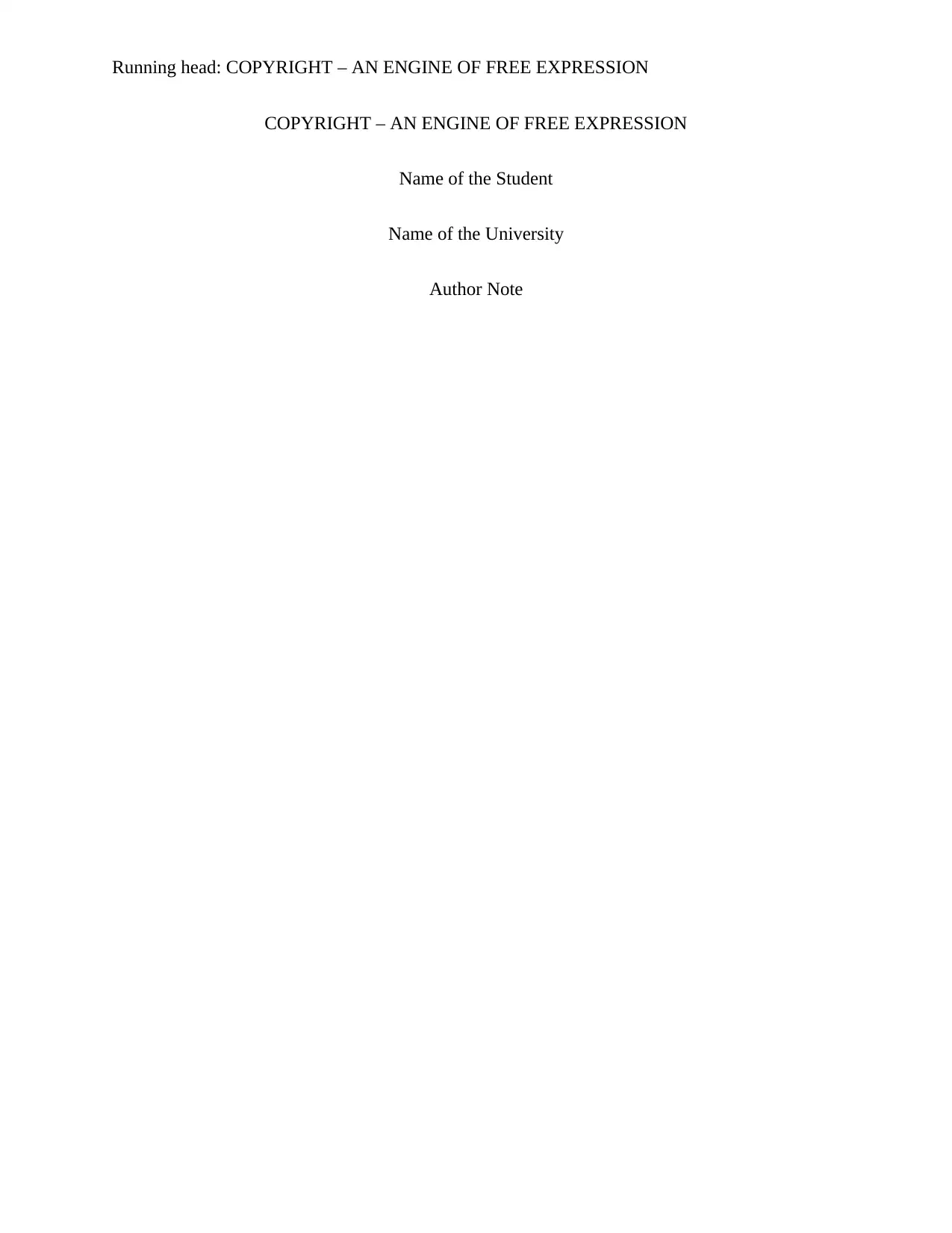
Running head: COPYRIGHT – AN ENGINE OF FREE EXPRESSION
COPYRIGHT – AN ENGINE OF FREE EXPRESSION
Name of the Student
Name of the University
Author Note
COPYRIGHT – AN ENGINE OF FREE EXPRESSION
Name of the Student
Name of the University
Author Note
Paraphrase This Document
Need a fresh take? Get an instant paraphrase of this document with our AI Paraphraser
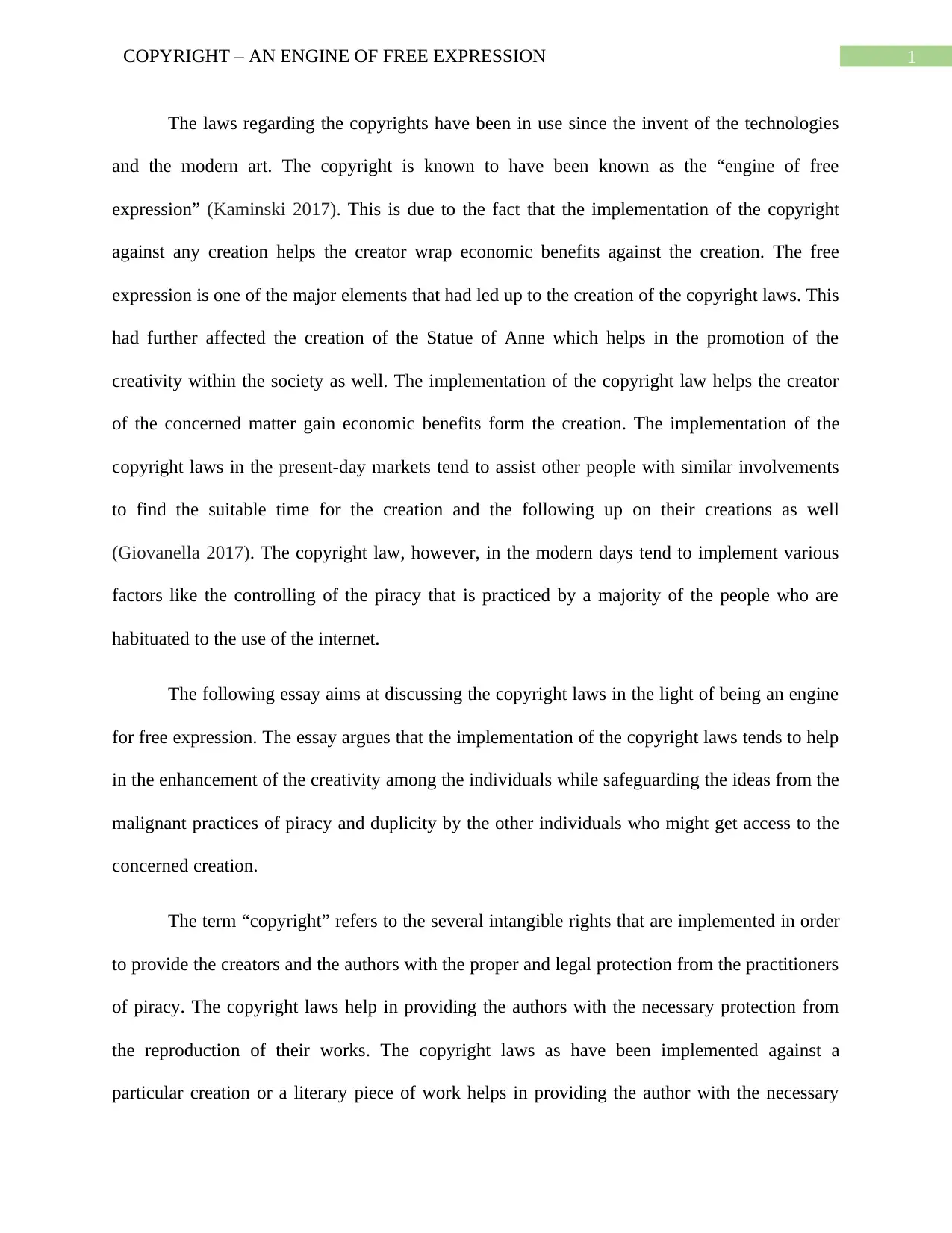
1COPYRIGHT – AN ENGINE OF FREE EXPRESSION
The laws regarding the copyrights have been in use since the invent of the technologies
and the modern art. The copyright is known to have been known as the “engine of free
expression” (Kaminski 2017). This is due to the fact that the implementation of the copyright
against any creation helps the creator wrap economic benefits against the creation. The free
expression is one of the major elements that had led up to the creation of the copyright laws. This
had further affected the creation of the Statue of Anne which helps in the promotion of the
creativity within the society as well. The implementation of the copyright law helps the creator
of the concerned matter gain economic benefits form the creation. The implementation of the
copyright laws in the present-day markets tend to assist other people with similar involvements
to find the suitable time for the creation and the following up on their creations as well
(Giovanella 2017). The copyright law, however, in the modern days tend to implement various
factors like the controlling of the piracy that is practiced by a majority of the people who are
habituated to the use of the internet.
The following essay aims at discussing the copyright laws in the light of being an engine
for free expression. The essay argues that the implementation of the copyright laws tends to help
in the enhancement of the creativity among the individuals while safeguarding the ideas from the
malignant practices of piracy and duplicity by the other individuals who might get access to the
concerned creation.
The term “copyright” refers to the several intangible rights that are implemented in order
to provide the creators and the authors with the proper and legal protection from the practitioners
of piracy. The copyright laws help in providing the authors with the necessary protection from
the reproduction of their works. The copyright laws as have been implemented against a
particular creation or a literary piece of work helps in providing the author with the necessary
The laws regarding the copyrights have been in use since the invent of the technologies
and the modern art. The copyright is known to have been known as the “engine of free
expression” (Kaminski 2017). This is due to the fact that the implementation of the copyright
against any creation helps the creator wrap economic benefits against the creation. The free
expression is one of the major elements that had led up to the creation of the copyright laws. This
had further affected the creation of the Statue of Anne which helps in the promotion of the
creativity within the society as well. The implementation of the copyright law helps the creator
of the concerned matter gain economic benefits form the creation. The implementation of the
copyright laws in the present-day markets tend to assist other people with similar involvements
to find the suitable time for the creation and the following up on their creations as well
(Giovanella 2017). The copyright law, however, in the modern days tend to implement various
factors like the controlling of the piracy that is practiced by a majority of the people who are
habituated to the use of the internet.
The following essay aims at discussing the copyright laws in the light of being an engine
for free expression. The essay argues that the implementation of the copyright laws tends to help
in the enhancement of the creativity among the individuals while safeguarding the ideas from the
malignant practices of piracy and duplicity by the other individuals who might get access to the
concerned creation.
The term “copyright” refers to the several intangible rights that are implemented in order
to provide the creators and the authors with the proper and legal protection from the practitioners
of piracy. The copyright laws help in providing the authors with the necessary protection from
the reproduction of their works. The copyright laws as have been implemented against a
particular creation or a literary piece of work helps in providing the author with the necessary
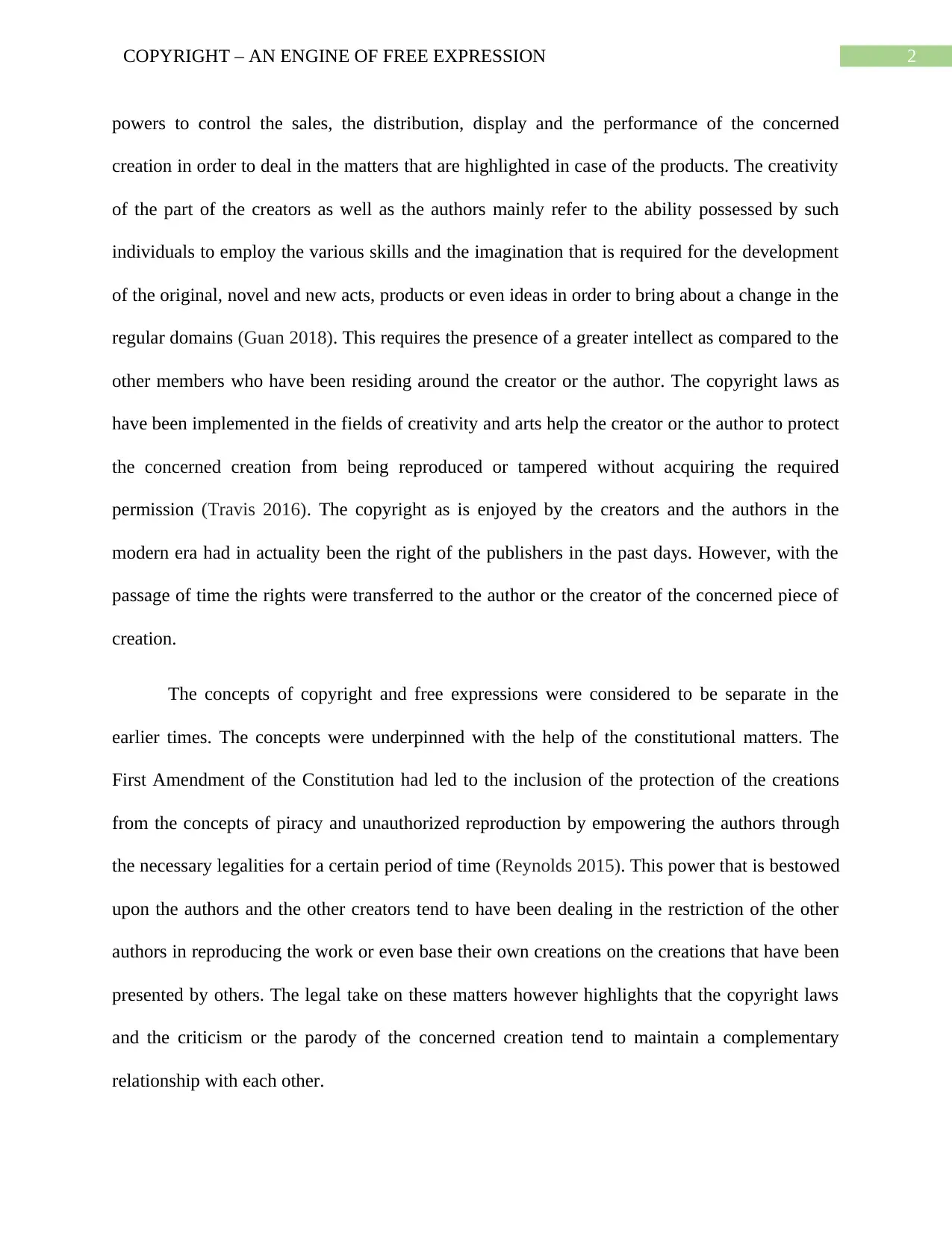
2COPYRIGHT – AN ENGINE OF FREE EXPRESSION
powers to control the sales, the distribution, display and the performance of the concerned
creation in order to deal in the matters that are highlighted in case of the products. The creativity
of the part of the creators as well as the authors mainly refer to the ability possessed by such
individuals to employ the various skills and the imagination that is required for the development
of the original, novel and new acts, products or even ideas in order to bring about a change in the
regular domains (Guan 2018). This requires the presence of a greater intellect as compared to the
other members who have been residing around the creator or the author. The copyright laws as
have been implemented in the fields of creativity and arts help the creator or the author to protect
the concerned creation from being reproduced or tampered without acquiring the required
permission (Travis 2016). The copyright as is enjoyed by the creators and the authors in the
modern era had in actuality been the right of the publishers in the past days. However, with the
passage of time the rights were transferred to the author or the creator of the concerned piece of
creation.
The concepts of copyright and free expressions were considered to be separate in the
earlier times. The concepts were underpinned with the help of the constitutional matters. The
First Amendment of the Constitution had led to the inclusion of the protection of the creations
from the concepts of piracy and unauthorized reproduction by empowering the authors through
the necessary legalities for a certain period of time (Reynolds 2015). This power that is bestowed
upon the authors and the other creators tend to have been dealing in the restriction of the other
authors in reproducing the work or even base their own creations on the creations that have been
presented by others. The legal take on these matters however highlights that the copyright laws
and the criticism or the parody of the concerned creation tend to maintain a complementary
relationship with each other.
powers to control the sales, the distribution, display and the performance of the concerned
creation in order to deal in the matters that are highlighted in case of the products. The creativity
of the part of the creators as well as the authors mainly refer to the ability possessed by such
individuals to employ the various skills and the imagination that is required for the development
of the original, novel and new acts, products or even ideas in order to bring about a change in the
regular domains (Guan 2018). This requires the presence of a greater intellect as compared to the
other members who have been residing around the creator or the author. The copyright laws as
have been implemented in the fields of creativity and arts help the creator or the author to protect
the concerned creation from being reproduced or tampered without acquiring the required
permission (Travis 2016). The copyright as is enjoyed by the creators and the authors in the
modern era had in actuality been the right of the publishers in the past days. However, with the
passage of time the rights were transferred to the author or the creator of the concerned piece of
creation.
The concepts of copyright and free expressions were considered to be separate in the
earlier times. The concepts were underpinned with the help of the constitutional matters. The
First Amendment of the Constitution had led to the inclusion of the protection of the creations
from the concepts of piracy and unauthorized reproduction by empowering the authors through
the necessary legalities for a certain period of time (Reynolds 2015). This power that is bestowed
upon the authors and the other creators tend to have been dealing in the restriction of the other
authors in reproducing the work or even base their own creations on the creations that have been
presented by others. The legal take on these matters however highlights that the copyright laws
and the criticism or the parody of the concerned creation tend to maintain a complementary
relationship with each other.
⊘ This is a preview!⊘
Do you want full access?
Subscribe today to unlock all pages.

Trusted by 1+ million students worldwide
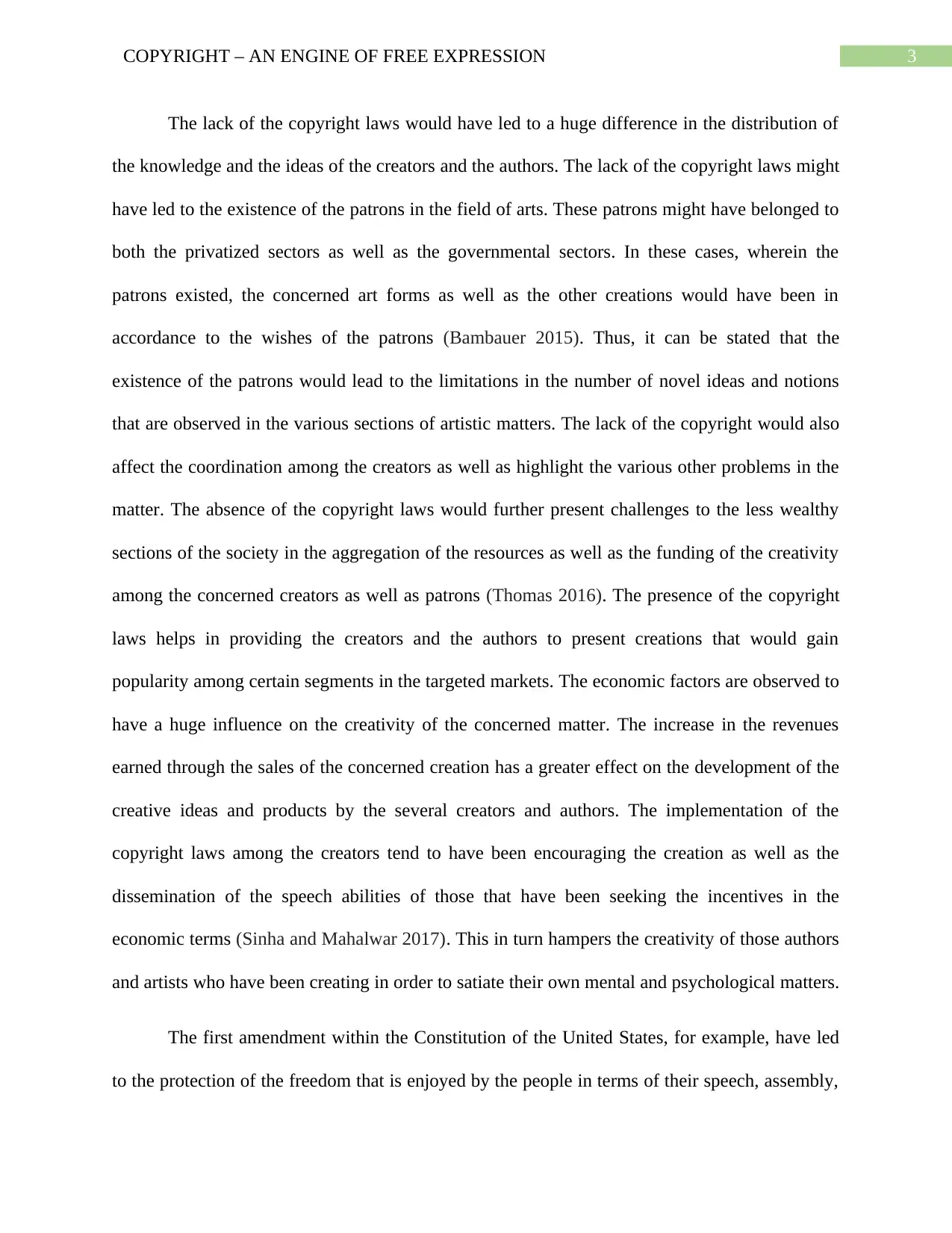
3COPYRIGHT – AN ENGINE OF FREE EXPRESSION
The lack of the copyright laws would have led to a huge difference in the distribution of
the knowledge and the ideas of the creators and the authors. The lack of the copyright laws might
have led to the existence of the patrons in the field of arts. These patrons might have belonged to
both the privatized sectors as well as the governmental sectors. In these cases, wherein the
patrons existed, the concerned art forms as well as the other creations would have been in
accordance to the wishes of the patrons (Bambauer 2015). Thus, it can be stated that the
existence of the patrons would lead to the limitations in the number of novel ideas and notions
that are observed in the various sections of artistic matters. The lack of the copyright would also
affect the coordination among the creators as well as highlight the various other problems in the
matter. The absence of the copyright laws would further present challenges to the less wealthy
sections of the society in the aggregation of the resources as well as the funding of the creativity
among the concerned creators as well as patrons (Thomas 2016). The presence of the copyright
laws helps in providing the creators and the authors to present creations that would gain
popularity among certain segments in the targeted markets. The economic factors are observed to
have a huge influence on the creativity of the concerned matter. The increase in the revenues
earned through the sales of the concerned creation has a greater effect on the development of the
creative ideas and products by the several creators and authors. The implementation of the
copyright laws among the creators tend to have been encouraging the creation as well as the
dissemination of the speech abilities of those that have been seeking the incentives in the
economic terms (Sinha and Mahalwar 2017). This in turn hampers the creativity of those authors
and artists who have been creating in order to satiate their own mental and psychological matters.
The first amendment within the Constitution of the United States, for example, have led
to the protection of the freedom that is enjoyed by the people in terms of their speech, assembly,
The lack of the copyright laws would have led to a huge difference in the distribution of
the knowledge and the ideas of the creators and the authors. The lack of the copyright laws might
have led to the existence of the patrons in the field of arts. These patrons might have belonged to
both the privatized sectors as well as the governmental sectors. In these cases, wherein the
patrons existed, the concerned art forms as well as the other creations would have been in
accordance to the wishes of the patrons (Bambauer 2015). Thus, it can be stated that the
existence of the patrons would lead to the limitations in the number of novel ideas and notions
that are observed in the various sections of artistic matters. The lack of the copyright would also
affect the coordination among the creators as well as highlight the various other problems in the
matter. The absence of the copyright laws would further present challenges to the less wealthy
sections of the society in the aggregation of the resources as well as the funding of the creativity
among the concerned creators as well as patrons (Thomas 2016). The presence of the copyright
laws helps in providing the creators and the authors to present creations that would gain
popularity among certain segments in the targeted markets. The economic factors are observed to
have a huge influence on the creativity of the concerned matter. The increase in the revenues
earned through the sales of the concerned creation has a greater effect on the development of the
creative ideas and products by the several creators and authors. The implementation of the
copyright laws among the creators tend to have been encouraging the creation as well as the
dissemination of the speech abilities of those that have been seeking the incentives in the
economic terms (Sinha and Mahalwar 2017). This in turn hampers the creativity of those authors
and artists who have been creating in order to satiate their own mental and psychological matters.
The first amendment within the Constitution of the United States, for example, have led
to the protection of the freedom that is enjoyed by the people in terms of their speech, assembly,
Paraphrase This Document
Need a fresh take? Get an instant paraphrase of this document with our AI Paraphraser
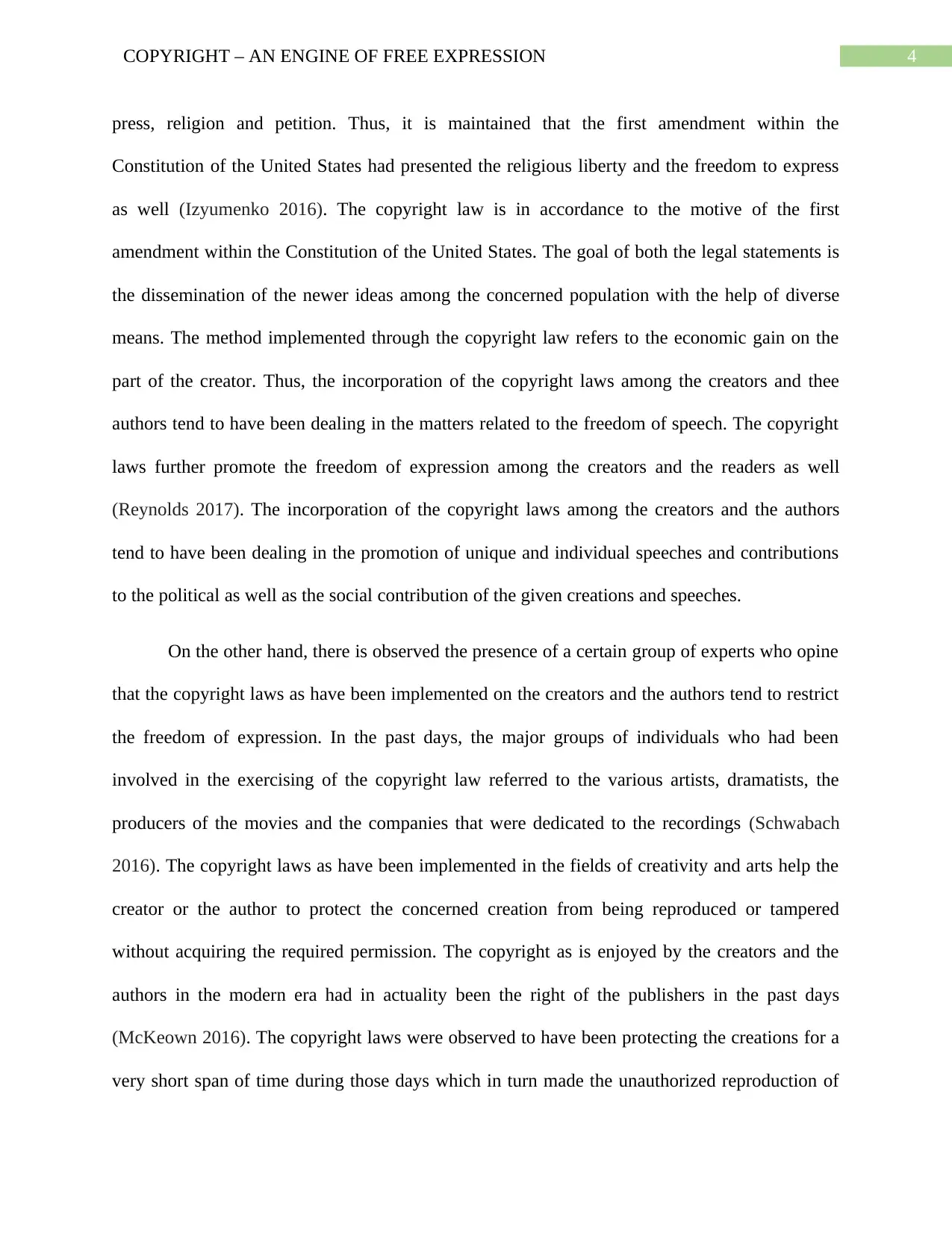
4COPYRIGHT – AN ENGINE OF FREE EXPRESSION
press, religion and petition. Thus, it is maintained that the first amendment within the
Constitution of the United States had presented the religious liberty and the freedom to express
as well (Izyumenko 2016). The copyright law is in accordance to the motive of the first
amendment within the Constitution of the United States. The goal of both the legal statements is
the dissemination of the newer ideas among the concerned population with the help of diverse
means. The method implemented through the copyright law refers to the economic gain on the
part of the creator. Thus, the incorporation of the copyright laws among the creators and thee
authors tend to have been dealing in the matters related to the freedom of speech. The copyright
laws further promote the freedom of expression among the creators and the readers as well
(Reynolds 2017). The incorporation of the copyright laws among the creators and the authors
tend to have been dealing in the promotion of unique and individual speeches and contributions
to the political as well as the social contribution of the given creations and speeches.
On the other hand, there is observed the presence of a certain group of experts who opine
that the copyright laws as have been implemented on the creators and the authors tend to restrict
the freedom of expression. In the past days, the major groups of individuals who had been
involved in the exercising of the copyright law referred to the various artists, dramatists, the
producers of the movies and the companies that were dedicated to the recordings (Schwabach
2016). The copyright laws as have been implemented in the fields of creativity and arts help the
creator or the author to protect the concerned creation from being reproduced or tampered
without acquiring the required permission. The copyright as is enjoyed by the creators and the
authors in the modern era had in actuality been the right of the publishers in the past days
(McKeown 2016). The copyright laws were observed to have been protecting the creations for a
very short span of time during those days which in turn made the unauthorized reproduction of
press, religion and petition. Thus, it is maintained that the first amendment within the
Constitution of the United States had presented the religious liberty and the freedom to express
as well (Izyumenko 2016). The copyright law is in accordance to the motive of the first
amendment within the Constitution of the United States. The goal of both the legal statements is
the dissemination of the newer ideas among the concerned population with the help of diverse
means. The method implemented through the copyright law refers to the economic gain on the
part of the creator. Thus, the incorporation of the copyright laws among the creators and thee
authors tend to have been dealing in the matters related to the freedom of speech. The copyright
laws further promote the freedom of expression among the creators and the readers as well
(Reynolds 2017). The incorporation of the copyright laws among the creators and the authors
tend to have been dealing in the promotion of unique and individual speeches and contributions
to the political as well as the social contribution of the given creations and speeches.
On the other hand, there is observed the presence of a certain group of experts who opine
that the copyright laws as have been implemented on the creators and the authors tend to restrict
the freedom of expression. In the past days, the major groups of individuals who had been
involved in the exercising of the copyright law referred to the various artists, dramatists, the
producers of the movies and the companies that were dedicated to the recordings (Schwabach
2016). The copyright laws as have been implemented in the fields of creativity and arts help the
creator or the author to protect the concerned creation from being reproduced or tampered
without acquiring the required permission. The copyright as is enjoyed by the creators and the
authors in the modern era had in actuality been the right of the publishers in the past days
(McKeown 2016). The copyright laws were observed to have been protecting the creations for a
very short span of time during those days which in turn made the unauthorized reproduction of
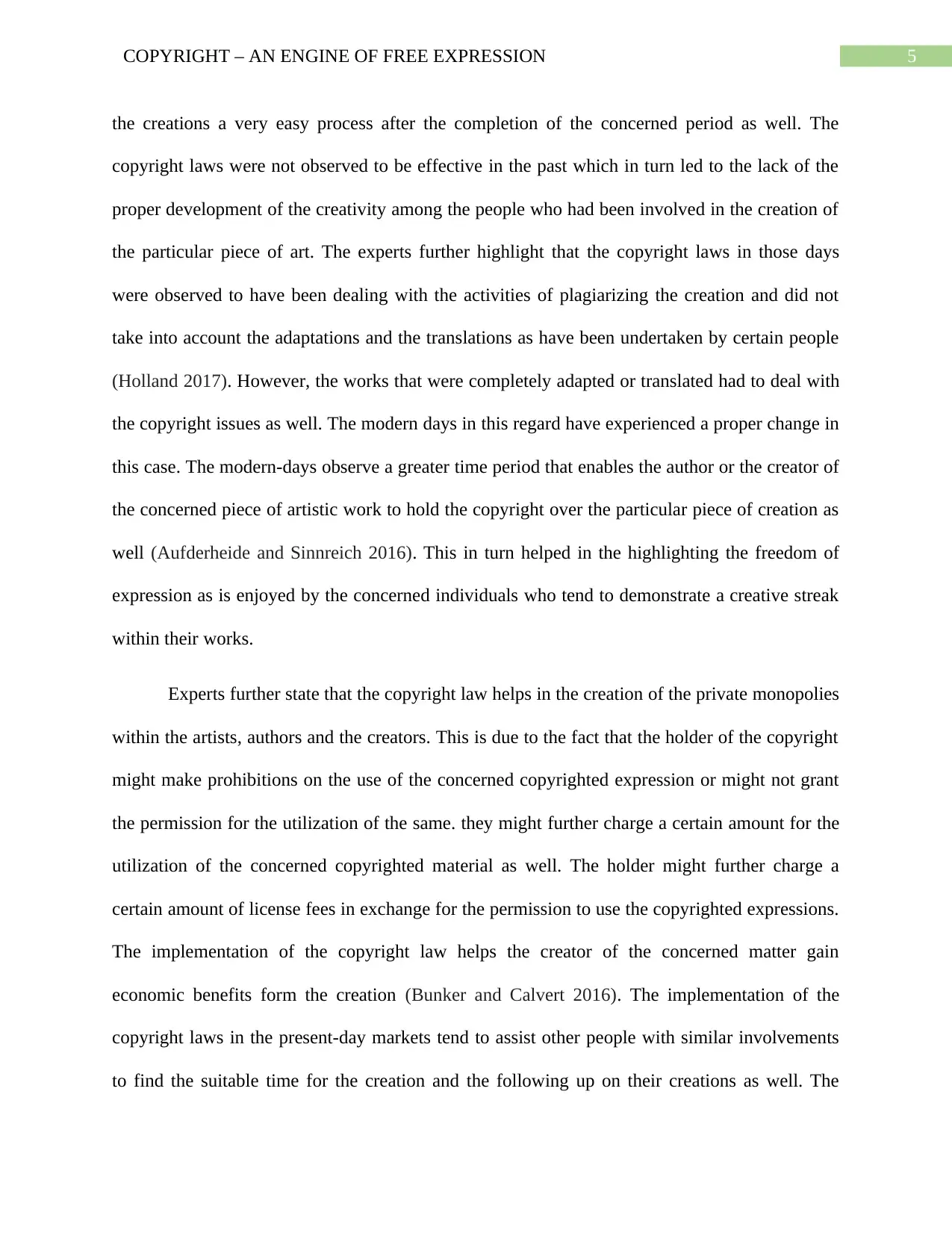
5COPYRIGHT – AN ENGINE OF FREE EXPRESSION
the creations a very easy process after the completion of the concerned period as well. The
copyright laws were not observed to be effective in the past which in turn led to the lack of the
proper development of the creativity among the people who had been involved in the creation of
the particular piece of art. The experts further highlight that the copyright laws in those days
were observed to have been dealing with the activities of plagiarizing the creation and did not
take into account the adaptations and the translations as have been undertaken by certain people
(Holland 2017). However, the works that were completely adapted or translated had to deal with
the copyright issues as well. The modern days in this regard have experienced a proper change in
this case. The modern-days observe a greater time period that enables the author or the creator of
the concerned piece of artistic work to hold the copyright over the particular piece of creation as
well (Aufderheide and Sinnreich 2016). This in turn helped in the highlighting the freedom of
expression as is enjoyed by the concerned individuals who tend to demonstrate a creative streak
within their works.
Experts further state that the copyright law helps in the creation of the private monopolies
within the artists, authors and the creators. This is due to the fact that the holder of the copyright
might make prohibitions on the use of the concerned copyrighted expression or might not grant
the permission for the utilization of the same. they might further charge a certain amount for the
utilization of the concerned copyrighted material as well. The holder might further charge a
certain amount of license fees in exchange for the permission to use the copyrighted expressions.
The implementation of the copyright law helps the creator of the concerned matter gain
economic benefits form the creation (Bunker and Calvert 2016). The implementation of the
copyright laws in the present-day markets tend to assist other people with similar involvements
to find the suitable time for the creation and the following up on their creations as well. The
the creations a very easy process after the completion of the concerned period as well. The
copyright laws were not observed to be effective in the past which in turn led to the lack of the
proper development of the creativity among the people who had been involved in the creation of
the particular piece of art. The experts further highlight that the copyright laws in those days
were observed to have been dealing with the activities of plagiarizing the creation and did not
take into account the adaptations and the translations as have been undertaken by certain people
(Holland 2017). However, the works that were completely adapted or translated had to deal with
the copyright issues as well. The modern days in this regard have experienced a proper change in
this case. The modern-days observe a greater time period that enables the author or the creator of
the concerned piece of artistic work to hold the copyright over the particular piece of creation as
well (Aufderheide and Sinnreich 2016). This in turn helped in the highlighting the freedom of
expression as is enjoyed by the concerned individuals who tend to demonstrate a creative streak
within their works.
Experts further state that the copyright law helps in the creation of the private monopolies
within the artists, authors and the creators. This is due to the fact that the holder of the copyright
might make prohibitions on the use of the concerned copyrighted expression or might not grant
the permission for the utilization of the same. they might further charge a certain amount for the
utilization of the concerned copyrighted material as well. The holder might further charge a
certain amount of license fees in exchange for the permission to use the copyrighted expressions.
The implementation of the copyright law helps the creator of the concerned matter gain
economic benefits form the creation (Bunker and Calvert 2016). The implementation of the
copyright laws in the present-day markets tend to assist other people with similar involvements
to find the suitable time for the creation and the following up on their creations as well. The
⊘ This is a preview!⊘
Do you want full access?
Subscribe today to unlock all pages.

Trusted by 1+ million students worldwide
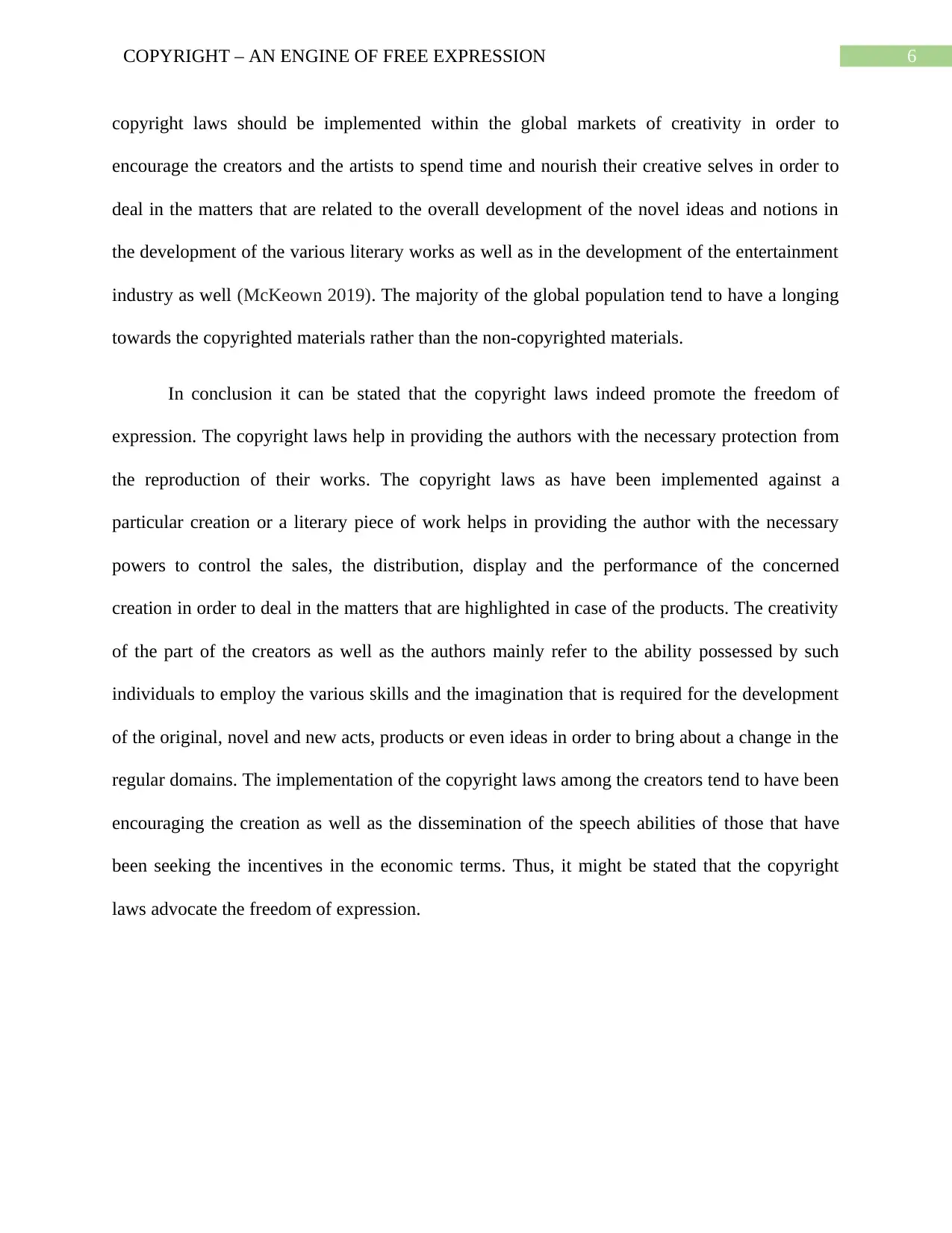
6COPYRIGHT – AN ENGINE OF FREE EXPRESSION
copyright laws should be implemented within the global markets of creativity in order to
encourage the creators and the artists to spend time and nourish their creative selves in order to
deal in the matters that are related to the overall development of the novel ideas and notions in
the development of the various literary works as well as in the development of the entertainment
industry as well (McKeown 2019). The majority of the global population tend to have a longing
towards the copyrighted materials rather than the non-copyrighted materials.
In conclusion it can be stated that the copyright laws indeed promote the freedom of
expression. The copyright laws help in providing the authors with the necessary protection from
the reproduction of their works. The copyright laws as have been implemented against a
particular creation or a literary piece of work helps in providing the author with the necessary
powers to control the sales, the distribution, display and the performance of the concerned
creation in order to deal in the matters that are highlighted in case of the products. The creativity
of the part of the creators as well as the authors mainly refer to the ability possessed by such
individuals to employ the various skills and the imagination that is required for the development
of the original, novel and new acts, products or even ideas in order to bring about a change in the
regular domains. The implementation of the copyright laws among the creators tend to have been
encouraging the creation as well as the dissemination of the speech abilities of those that have
been seeking the incentives in the economic terms. Thus, it might be stated that the copyright
laws advocate the freedom of expression.
copyright laws should be implemented within the global markets of creativity in order to
encourage the creators and the artists to spend time and nourish their creative selves in order to
deal in the matters that are related to the overall development of the novel ideas and notions in
the development of the various literary works as well as in the development of the entertainment
industry as well (McKeown 2019). The majority of the global population tend to have a longing
towards the copyrighted materials rather than the non-copyrighted materials.
In conclusion it can be stated that the copyright laws indeed promote the freedom of
expression. The copyright laws help in providing the authors with the necessary protection from
the reproduction of their works. The copyright laws as have been implemented against a
particular creation or a literary piece of work helps in providing the author with the necessary
powers to control the sales, the distribution, display and the performance of the concerned
creation in order to deal in the matters that are highlighted in case of the products. The creativity
of the part of the creators as well as the authors mainly refer to the ability possessed by such
individuals to employ the various skills and the imagination that is required for the development
of the original, novel and new acts, products or even ideas in order to bring about a change in the
regular domains. The implementation of the copyright laws among the creators tend to have been
encouraging the creation as well as the dissemination of the speech abilities of those that have
been seeking the incentives in the economic terms. Thus, it might be stated that the copyright
laws advocate the freedom of expression.
Paraphrase This Document
Need a fresh take? Get an instant paraphrase of this document with our AI Paraphraser
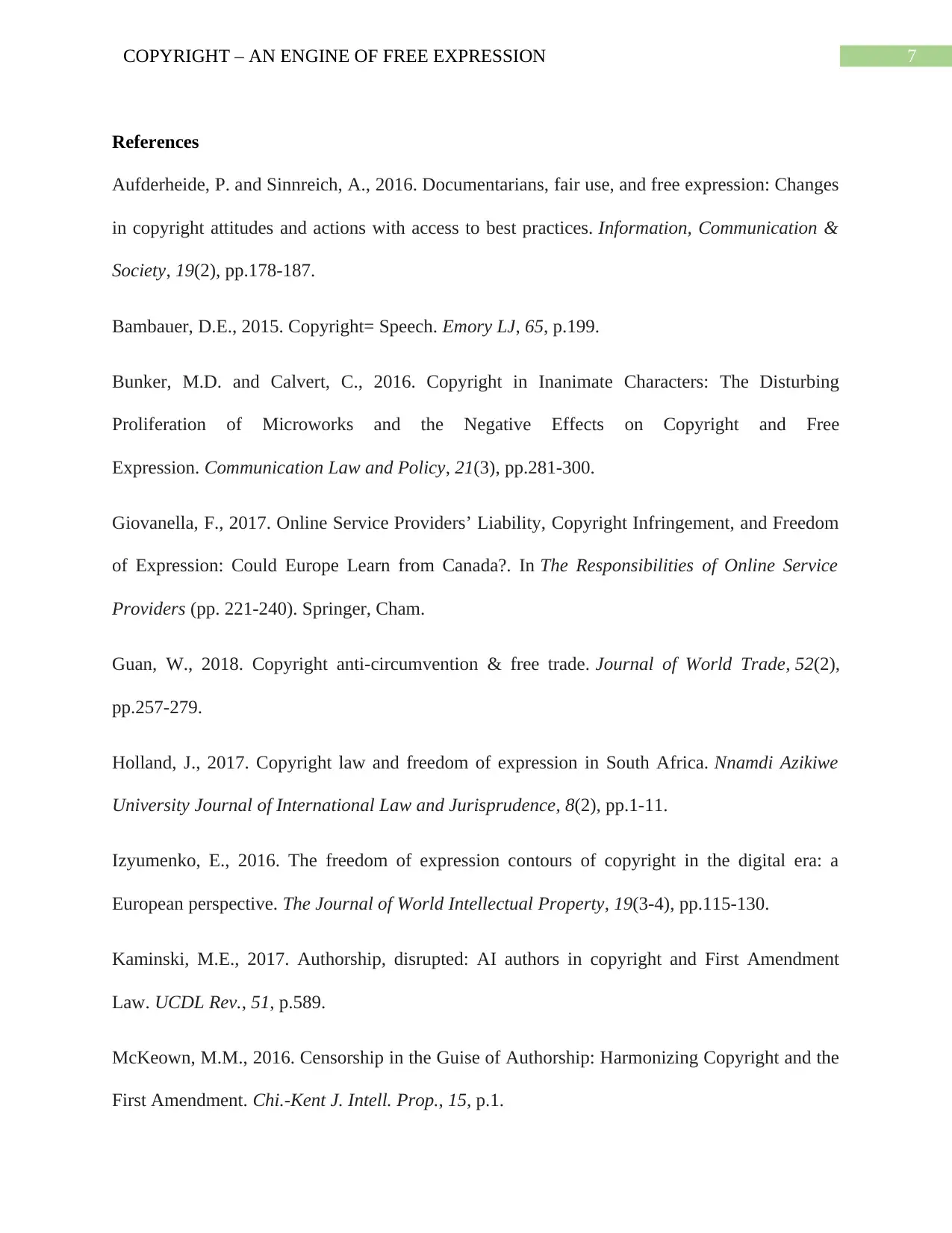
7COPYRIGHT – AN ENGINE OF FREE EXPRESSION
References
Aufderheide, P. and Sinnreich, A., 2016. Documentarians, fair use, and free expression: Changes
in copyright attitudes and actions with access to best practices. Information, Communication &
Society, 19(2), pp.178-187.
Bambauer, D.E., 2015. Copyright= Speech. Emory LJ, 65, p.199.
Bunker, M.D. and Calvert, C., 2016. Copyright in Inanimate Characters: The Disturbing
Proliferation of Microworks and the Negative Effects on Copyright and Free
Expression. Communication Law and Policy, 21(3), pp.281-300.
Giovanella, F., 2017. Online Service Providers’ Liability, Copyright Infringement, and Freedom
of Expression: Could Europe Learn from Canada?. In The Responsibilities of Online Service
Providers (pp. 221-240). Springer, Cham.
Guan, W., 2018. Copyright anti-circumvention & free trade. Journal of World Trade, 52(2),
pp.257-279.
Holland, J., 2017. Copyright law and freedom of expression in South Africa. Nnamdi Azikiwe
University Journal of International Law and Jurisprudence, 8(2), pp.1-11.
Izyumenko, E., 2016. The freedom of expression contours of copyright in the digital era: a
European perspective. The Journal of World Intellectual Property, 19(3-4), pp.115-130.
Kaminski, M.E., 2017. Authorship, disrupted: AI authors in copyright and First Amendment
Law. UCDL Rev., 51, p.589.
McKeown, M.M., 2016. Censorship in the Guise of Authorship: Harmonizing Copyright and the
First Amendment. Chi.-Kent J. Intell. Prop., 15, p.1.
References
Aufderheide, P. and Sinnreich, A., 2016. Documentarians, fair use, and free expression: Changes
in copyright attitudes and actions with access to best practices. Information, Communication &
Society, 19(2), pp.178-187.
Bambauer, D.E., 2015. Copyright= Speech. Emory LJ, 65, p.199.
Bunker, M.D. and Calvert, C., 2016. Copyright in Inanimate Characters: The Disturbing
Proliferation of Microworks and the Negative Effects on Copyright and Free
Expression. Communication Law and Policy, 21(3), pp.281-300.
Giovanella, F., 2017. Online Service Providers’ Liability, Copyright Infringement, and Freedom
of Expression: Could Europe Learn from Canada?. In The Responsibilities of Online Service
Providers (pp. 221-240). Springer, Cham.
Guan, W., 2018. Copyright anti-circumvention & free trade. Journal of World Trade, 52(2),
pp.257-279.
Holland, J., 2017. Copyright law and freedom of expression in South Africa. Nnamdi Azikiwe
University Journal of International Law and Jurisprudence, 8(2), pp.1-11.
Izyumenko, E., 2016. The freedom of expression contours of copyright in the digital era: a
European perspective. The Journal of World Intellectual Property, 19(3-4), pp.115-130.
Kaminski, M.E., 2017. Authorship, disrupted: AI authors in copyright and First Amendment
Law. UCDL Rev., 51, p.589.
McKeown, M.M., 2016. Censorship in the Guise of Authorship: Harmonizing Copyright and the
First Amendment. Chi.-Kent J. Intell. Prop., 15, p.1.
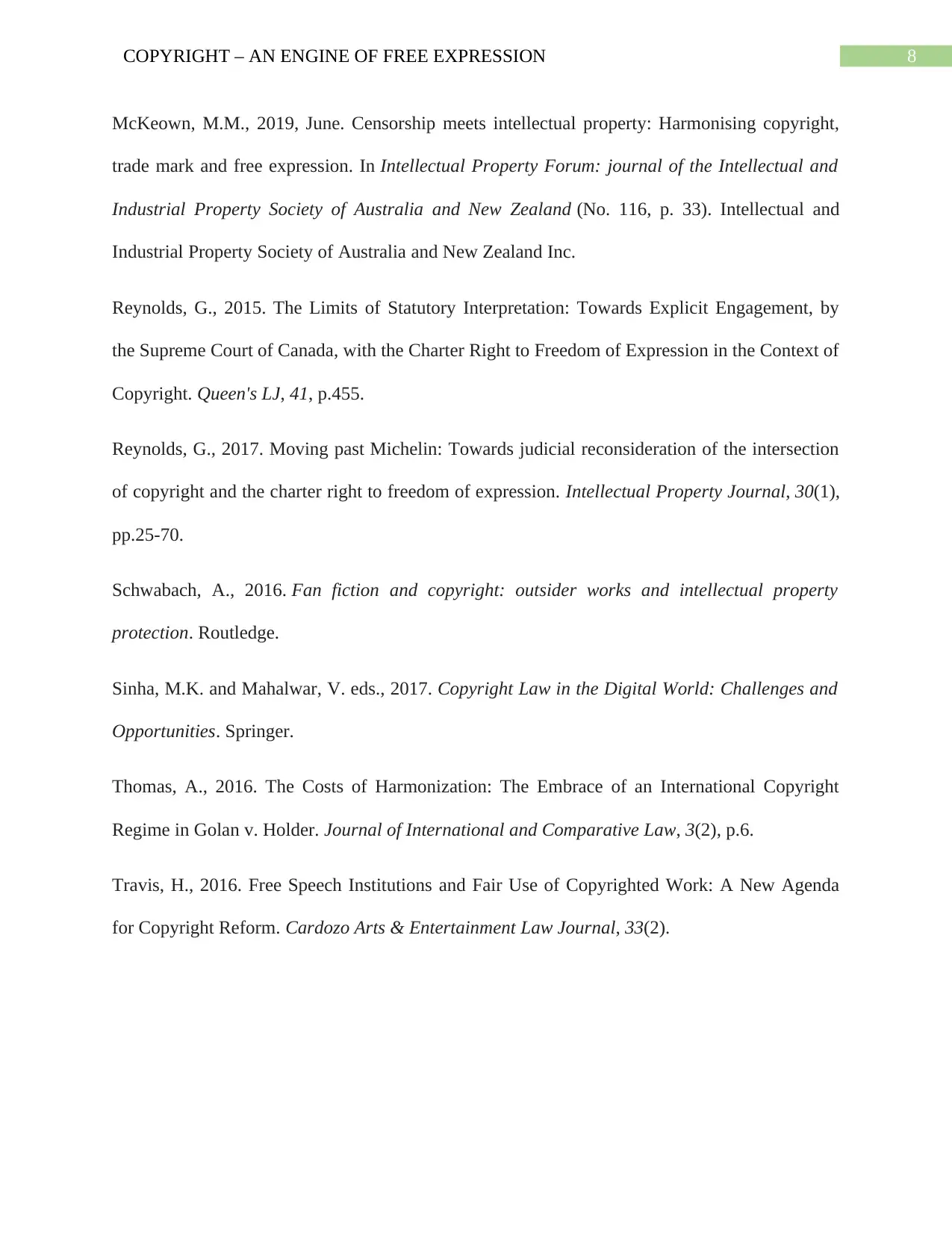
8COPYRIGHT – AN ENGINE OF FREE EXPRESSION
McKeown, M.M., 2019, June. Censorship meets intellectual property: Harmonising copyright,
trade mark and free expression. In Intellectual Property Forum: journal of the Intellectual and
Industrial Property Society of Australia and New Zealand (No. 116, p. 33). Intellectual and
Industrial Property Society of Australia and New Zealand Inc.
Reynolds, G., 2015. The Limits of Statutory Interpretation: Towards Explicit Engagement, by
the Supreme Court of Canada, with the Charter Right to Freedom of Expression in the Context of
Copyright. Queen's LJ, 41, p.455.
Reynolds, G., 2017. Moving past Michelin: Towards judicial reconsideration of the intersection
of copyright and the charter right to freedom of expression. Intellectual Property Journal, 30(1),
pp.25-70.
Schwabach, A., 2016. Fan fiction and copyright: outsider works and intellectual property
protection. Routledge.
Sinha, M.K. and Mahalwar, V. eds., 2017. Copyright Law in the Digital World: Challenges and
Opportunities. Springer.
Thomas, A., 2016. The Costs of Harmonization: The Embrace of an International Copyright
Regime in Golan v. Holder. Journal of International and Comparative Law, 3(2), p.6.
Travis, H., 2016. Free Speech Institutions and Fair Use of Copyrighted Work: A New Agenda
for Copyright Reform. Cardozo Arts & Entertainment Law Journal, 33(2).
McKeown, M.M., 2019, June. Censorship meets intellectual property: Harmonising copyright,
trade mark and free expression. In Intellectual Property Forum: journal of the Intellectual and
Industrial Property Society of Australia and New Zealand (No. 116, p. 33). Intellectual and
Industrial Property Society of Australia and New Zealand Inc.
Reynolds, G., 2015. The Limits of Statutory Interpretation: Towards Explicit Engagement, by
the Supreme Court of Canada, with the Charter Right to Freedom of Expression in the Context of
Copyright. Queen's LJ, 41, p.455.
Reynolds, G., 2017. Moving past Michelin: Towards judicial reconsideration of the intersection
of copyright and the charter right to freedom of expression. Intellectual Property Journal, 30(1),
pp.25-70.
Schwabach, A., 2016. Fan fiction and copyright: outsider works and intellectual property
protection. Routledge.
Sinha, M.K. and Mahalwar, V. eds., 2017. Copyright Law in the Digital World: Challenges and
Opportunities. Springer.
Thomas, A., 2016. The Costs of Harmonization: The Embrace of an International Copyright
Regime in Golan v. Holder. Journal of International and Comparative Law, 3(2), p.6.
Travis, H., 2016. Free Speech Institutions and Fair Use of Copyrighted Work: A New Agenda
for Copyright Reform. Cardozo Arts & Entertainment Law Journal, 33(2).
⊘ This is a preview!⊘
Do you want full access?
Subscribe today to unlock all pages.

Trusted by 1+ million students worldwide
1 out of 9
Related Documents
Your All-in-One AI-Powered Toolkit for Academic Success.
+13062052269
info@desklib.com
Available 24*7 on WhatsApp / Email
![[object Object]](/_next/static/media/star-bottom.7253800d.svg)
Unlock your academic potential
Copyright © 2020–2025 A2Z Services. All Rights Reserved. Developed and managed by ZUCOL.





